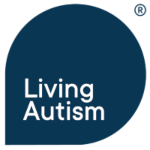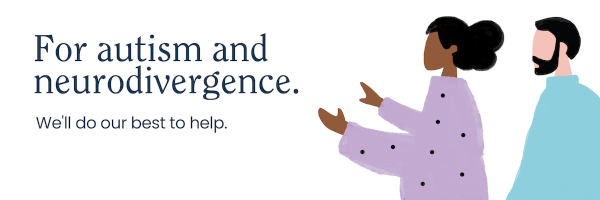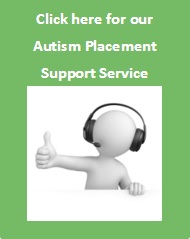We often receive enquiries from people who wonder if their family member or friend might have Asperger’s Syndrome or are somewhere on the autism spectrum. Asperger’s Syndrome has been a term used during the past 40 years or so to describe individuals who have autism characteristics and who are of normal or above normal intelligence. In 2013, the DSM 5, an American diagnostic manual, got rid of the term Asperger’s Syndrome as a diagnosis on its own and included it in the wider term for the autism spectrum – Autism Spectrum Disorder.
Whatever the term, the fact is that there are individuals who are very competent in their chosen course of study or work, but who struggle with social communication difficulties and the need for structure and routine. Of course, diagnoses need to be carried out by the appropriate professionals and no-one can give a diagnosis by proxy. Furthermore, every person with autism is an individual with their own wishes and aspirations and their own specific needs. However, we can provide you with some basic characteristics to look out for and some basic strategies that have been shown to be successful in supporting people with autism taken from our team’s experiences over the past 20 years.
If you are reading this article and you feel you might be on the autism spectrum then you might recognize some of the characteristics in yourself and you might find the strategies helpful. You might also consider getting a diagnosis by approaching your GP.
Please note that the identifiers below are only indicators and it is important to stress that an individual may exhibit some of these traits and not have Asperger’s/autism. Furthermore, each individual with high-functioning autism will experience different elements of these indicators and in different combinations. It is probable, however, that they will experience an element from each of the categories.
Some qualities and strengths
Like anyone, those with Asperger’s/autism can have particular strengths and qualities and it is important to look at some of the attributes which someone with Asperger’s/autism brings. These can be as follows:
- excellent memory;
- precision and attention to detail;
- mathematical and technical skills;
- a preference for following instructions and abiding by rules;
- sticking to structured programmes;
- direct, open and honest;
- reproduction, imitation and mimicry;
- high level of vocabulary;
- dealing with projects which have a clear beginning, middle and end.
This means people with Asperger’s/autism can thrive in sectors which require precision and detail, such as accountancy, computing, engineering and architecture to name but a few. Because of the mathematical nature of music, they can also be quite musical. In addition, they can blossom in environments which provide clear structures and parameters and few unknowns.
Sensory differences
People with Asperger’s/autism can be either hyper-sensitive or hyposensitive. If they are hyper-sensitive then the senses can be more honed than usual and, therefore, sounds can seem louder, lights brighter, smells and tastes stronger; and touch keener; thus, the person can receive environmental information at a much greater intensity. If they are hypo-sensitive, they cannot process sensory input as effectively and, for example, might not feel hot water to the extent that they might get scalded. These sensory differences can mean:
- an acute sense of hearing or not being able to hear clearly;
- an ability to see in detail or inability to see the whole because of too much detail;
- a discriminatory sense of smell and taste;
- an extreme sensitivity to touch, textures and pressures or a need for stronger textures and increased pressure.
Differences in social communication
People with Asperger’s/autism can have a high level of vocabulary aided by their excellent memory skills. However, they could find contextualizing of language and abstract language difficult to understand. Furthermore, whilst most people pick up social cues which are sometimes illogical or which are dependent upon ‘seeing’ the entirety of a situation and not just one aspect, people with Asperger’s/autism could have some difficulty in detecting subtle and non-verbal communications. You might notice difficulties in:
- engaging in or understanding small talk;
- understanding body language and facial expressions;
- understanding sarcasm, jokes, irony (those with Asperger’s could have a tendency to be very literal in their understanding);
- understanding verbal communication without corresponding verbal cues, for example: notes, diagrams.
- showing empathy and understanding of others;
- keeping eye contact;
- speaking untruths in order not to offend; understand personal space;
- understanding social rules which are not based upon logic;
- understanding the complexities of inter-personal relationships.
Differences in need for structure and routine
Flexibility of thought is the ability to hazard a guess at the unknown, to cope with the unexpected, to act upon a whim. The sense of security brought on by the known can lead to the following:
- becoming obsessed with an interest, place or person;
- becoming anxious by change, spontaneity and unplanned events;
- experiencing difficulties in coping with the unknown (new people, new places, new situations);
- experiencing difficulties in remembering sequences without prompts, such as: diary, personal planner, alarm;
- experiencing difficulties in comprehending abstract concepts (e.g., formality, spontaneity, fun, anxiety);
- reluctance in using own initiative
Perception
The results of having to deal with some of the above hurdles is that people with Asperger’s/autism or someone with similar experiences can sometimes be perceived to be:
- abrupt
- absent-minded
- anxious
- aggressive
- disorganised
- eccentric
- lost in their own world
- rude
- self-centred
- thoughtless
As a consequence, some students or employees with Asperger’s/autism, or with similar difficulties, can experience a greater incidence of complaints and disciplinary procedures which could be a mystery to them, thus adding to their difficulties.
What can you do to support someone with Asperger’s Syndrome/autism?
Asperger’s (now part of Autism Spectrum Disorder) is a lifelong condition and although people with Asperger’s/autism might have some learning difficulties, such as dyslexia, they are often of average or above average intelligence. The condition itself is not a learning disability although it can present obstacles to aspects of social and communication learning. The difficulties lie in the lack of understanding of the social nuances of communication and behaviour, dealing with unknown situations and people, problems in thinking through sequences or of consequences to actions, inabilities in forming overarching concepts from detailed information, inabilities to see things from another’s perspective and dealing with sensory differences.
Asperger’s/autism affects every individual differently. Every individual has their own personality, their own strengths and weaknesses and they have their own difficulties to overcome just like everyone else. However, hurdles can be overcome, anxieties and resultant absenteeism can be reduced and time can be focused more on enabling and empowering the individual rather than disciplining them.
What can be practically done to help these students or employees, who are quite often excellent at the technical component of their chosen subject?
You will have noticed that this article has been written in a more bulleted form than a prosaic one. This is to make it easier to read, as a mass of words can sometimes be difficult to process. This is an example of a small and simple strategy that can be incorporated in every day working life to enable a student/employee give of their best.
Some other helpful strategies are:
Aide-memoires
These help to reduce anxieties brought on by not knowing what has been planned or when events are taking place.
- Calendar
- PDAs
- Mobile phone reminders
- Alarms on watches, mobile phones
- To do lists
- Shopping lists
- Daily task lists
Clear instructions with a beginning, middle and end
This is particularly helpful if a person has difficulty stopping before a project or task has been fully completed, ie. must finish no matter what.
- Written instructions
- Written direction
- Clear interim steps
- Clear reporting instructions
Training in non-verbal communication
This training can help to reduce anxieties brought on by not understanding the behaviour of others. It also enhances two-way communication and social integration.
- Understanding body language
- Understanding social communication, e.g., the differences of communicating in a meeting and at a party
- Understanding how to soften factual information/communication, e.g., opening and closing of conversations, texts, emails, letters etc.
Training for teachers, lecturers, colleagues and managers to enable them to become aware of the condition
Whether a person actually has a diagnosis of Asperger’s/autism or experiences the same hurdles, the most difficult aspect of this way of being is the lack of understanding of the people around them. Some basic training would be beneficial to all.
It’s worth the effort
People with Asperger’s Syndrome/autism can bring richness to our lives by helping those of us who do not have the condition to see the world from a different perspective. They can help us to understand how many experiences we take for granted and how many strategies we pick up naturally which they have to learn cognitively.
If you feel that a friend, family member or colleague of yours fits into the above description, it is important to seek support and information both for them and for yourself.
Suggested further reading
Attwood, T; 2006. The complete guide to Aspergers syndrome. London: Jessica Kinglsey Publishers.
Bogdashina, O; 2005. Theory of mind and the triad of perspectives on autism and
Asperger syndrome: a view from the bridge. London: Jessica Kingsley Publishers.
Edmonds, G and Beardon, L (Ed); 2008. Asperger Syndrome and Employment. Adults Speak Out about Asperger Syndrome. London: Jessica Kingsley Publishers.
Gillberg, C; 2002. A guide to Asperger syndrome. Cambridge: Cambridge University Press.
Stanford, A; 2011. Business for Aspies: 42 Best Practices for Using Asperger Syndrome Traits at Work. London: Jessica Kingsley Publishers.



